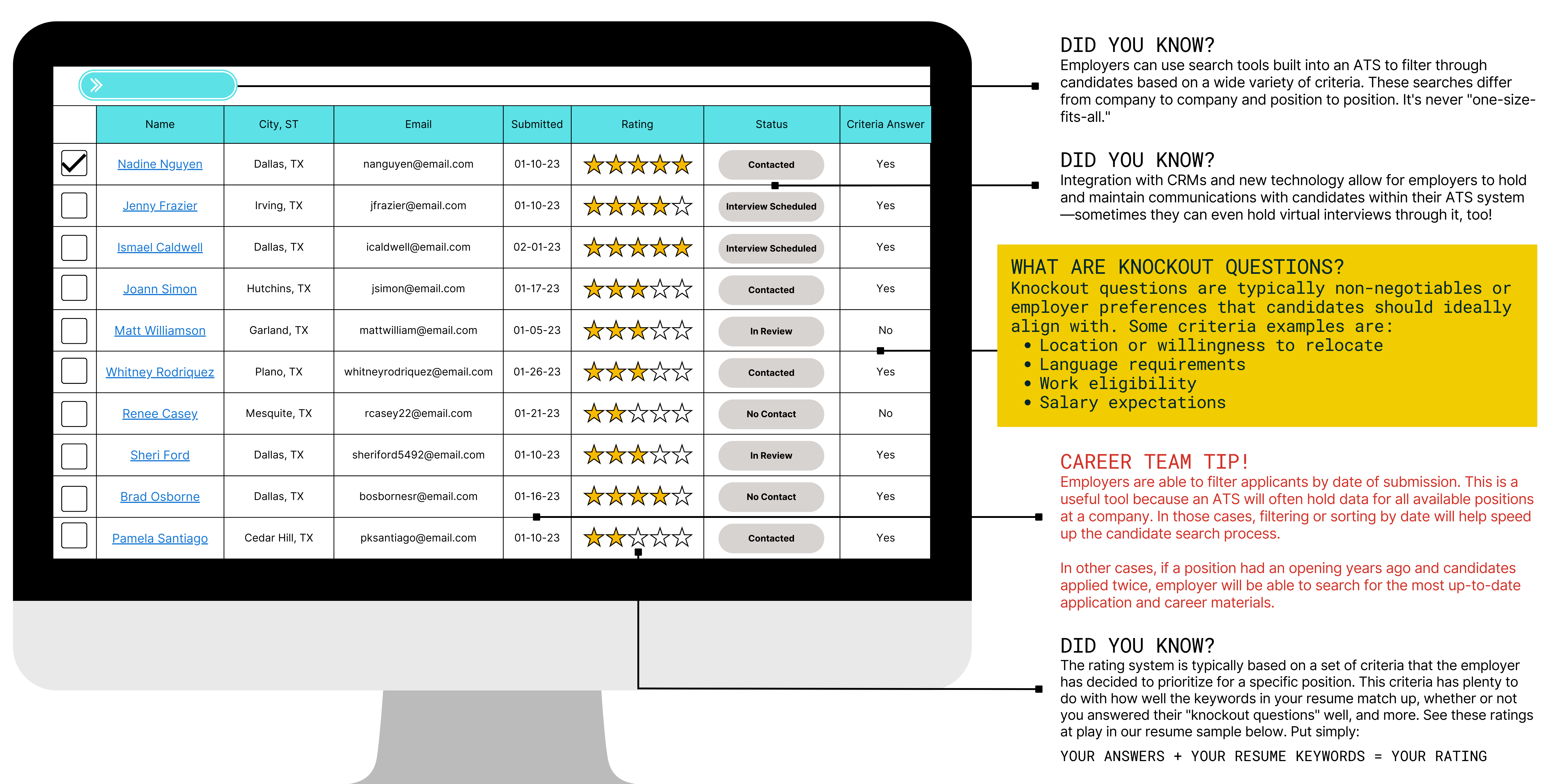If you have applied to jobs within the last few years, you probably know that there is no pairing of letters more frustrating than A, T, and S.
“It’s the bane of my existence,” career expert Alejandra Hernandez jokes.
Now an integral part of hiring, the Applicant Tracking System (or ATS) — creates an added layer of complexity when it comes to getting a recruiter’s attention.
This is likely not the first time you have heard of the ATS. But, it may be your first glimpse at what the system could look like on the backend.
We’re here to pull the curtain back on this elusive part of your job search.
While we can’t ensure that, with this information, you will “beat” the system every time (though we have tips for that), we hope that the extra context will help you understand what you’re up against the next time you hit submit on a job application.
Below, we’ll dive into what the ATS is, what recruiters see on the backend, and what approaches are best for overcoming the obstacles presented by ATS-powered hiring.
Introduction
Before diving into the components of an ATS, it’s important to understand the role it plays in the hiring process.

What is an applicant tracking system(ATS)?
In simple terms, an ATS is a database of applicants. Think of a digital filing cabinet where employers can store candidates, rank them, and search for them based on targeted criteria.
By utilizing this tool, recruiters can streamline their processes, making it much quicker and easier to identify qualified candidates. It’s great for:
- Selecting candidates who match job posting criteria
- Automating communication to candidates within a system
- Organizing and reviewing career materials and job applications
The applicant tracking systems were created to help employers systematize the hiring process and make informed decisions on quality candidates.
With efficiency still at its core today, ATSs have only gotten more sophisticated. Some ATS companies have even started to incorporate or integrate other tools such as candidate relationship management (CRM) software.
CRM tools enable hiring managers to communicate with potential candidates through its software features. Recruiters look at job applications, track their interactions with members of the company, and measure progress throughout the entire recruitment process. They’re great for:
- Maintaining communication with candidates and new hires
- Scheduling interviews with candidates
- Managing the offer and onboarding processes
When CRM software and ATSs work in tandem, hiring teams are able to do everything from posting jobs and syncing calendars to sending offer letters, all in one unified platform. Take Workable, for instance.
Platforms like Workable provide companies with valuable features to optimize the hiring process. But, automated hiring comes with its share of pitfalls.
Challenges presented by an automated system
According to Jobscan (2022), 98.8% of Fortune 500 companies use ATSs. That’s a lot of automation.
Our career experts agree. Over the years, they’ve observed a steady rise in the use of ATS technology and believe it won’t be going away anytime soon.
“What I am noticing — just from side conversations — is that, especially with all of those companies that let go of a lot of their folks, a lot of those recruiters got let go too,” Hernandez explains. “You have to think: there’s only one person for how many resumes that are coming in? So ATS is going nowhere.”
With so many companies relying on automation to fill roles, the likelihood of a human pulling your resume out of a pile remains low. This presents a unique challenge for candidates looking to stand out from the crowd.
Although ATS technology was created with a unified purpose in mind, it does not follow a “one-size-fits-all” model in application. In addition to your typical system-to-system variations, companies have the ability to customize their system, filter based on prioritized criteria, and organize applicants.
Because of this, when it comes to career materials, the goal for candidates is: fit the mold of what a position requires. Once you are able to make it past the automated system, you have a chance to show employers who you are and what sets you apart.
To prepare you for your next faceoff with an ATS and give you more perspective on how it affects your career, we mocked up our own version. This sample ATS should give you a better idea of what employers see on the backend, clarify different features and what they mean for your application, and teach you how to tailor your materials to reach the top of the pile.
A closer look: ATS features

You may be wondering which ATS our mockup is most identical to, and the reality is: it does not matter.
What matters is how each of these hypothetical candidates gets ranked by the system.
To better illustrate that, we created a sample resume for applicant Brad Osborne. In this sample, you will see where Osborne made mistakes and where he was successful in customizing his resume for the job at stake.

Tips to “beat” the ATS
Now that you have seen an example of ATS features, here are some tips to guide you in your job search:
Work with the system, not against it
Formatting matters when it comes to an ATS. Although your graphic resume may have visual appeal, if ATSs can’t read it, it could get disqualified.
ATS software parses information based on heading keywords, but any text presented in text boxes, columns, and tables is often scrambled or omitted. Colored text and images can also cause the software to skip sections of information. Because of this, for any online submissions, the goal is a very straightforward format with strong content.
When a computer might be reading through your resume, it’s also essential to proofread. Employers can use an ATS to check for grammar and spelling issues, which may disqualify you for lack of attention to detail.
Check out our Resume guide for more formatting tips.
Keywords matter
ATS rates your resume based on how it matches up with the job description. Make sure your resume reflects the exact keywords to optimize your score and get your materials in front of a recruiter. Remember to tailor your resume for each role you apply for.
Knockout questions have that name for a reason
Knockout questions are typically asked towards the beginning of an application and often require a simple “yes” or “no” answer. Despite their simplicity, your answers to these questions could instantaneously decide the fate of your application — which is why it is essential for you to check the basic criteria of a job before sending in that application.
Known to follow an assessment style of formatting, knockout questions can cover a variety of topics to ensure that you are qualified, willing, and able to perform key job functions. Keep your eye out for these questions on your next application and respond accordingly!
If you can’t beat ‘em, join ‘em
If you are not feeling confident about your resume’s ability to hold up against an automated system, we recommend that you use a resume scanner tool that can review your resume and see how it compares to a job listing. If applicable, the system will gather feedback to make suggestions on how to make your materials more “ATS-friendly.”
Spend your time wisely
If your resume does not make it through an ATS, the likelihood that someone will read your cover letter is low.
When it comes to your career materials, it’s all about balance. Don’t speed through your resume to give all your attention to writing a unique and inspiring cover letter — there are other ways to let your career story shine.
To learn more about writing an effective cover letter, check out our Cover letter guide.




